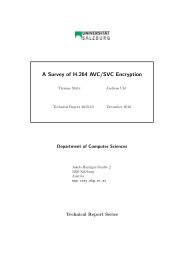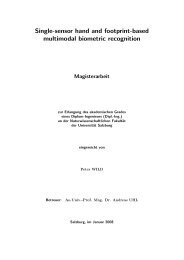Pit Pattern Classification in Colonoscopy using Wavelets - WaveLab
Pit Pattern Classification in Colonoscopy using Wavelets - WaveLab
Pit Pattern Classification in Colonoscopy using Wavelets - WaveLab
You also want an ePaper? Increase the reach of your titles
YUMPU automatically turns print PDFs into web optimized ePapers that Google loves.
5.2 Results<br />
<strong>Pit</strong> <strong>Pattern</strong> Type I II III-L III-S IV V<br />
k-NN<br />
I 60 6 16 0 17 0<br />
II 17 36 21 0 24 0<br />
III-L 16 3 57 0 22 0<br />
III-S 16 0 66 0 16 0<br />
IV 14 14 19 0 51 0<br />
V 4 24 8 0 64 0<br />
SVM<br />
I 47 15 17 0 19 1<br />
II 8 47 14 0 26 3<br />
III-L 15 6 47 0 28 1<br />
III-S 16 16 41 8 16 0<br />
IV 7 12 16 0 58 4<br />
V 12 20 8 0 40 20<br />
Table 5.15: Result distribution matrices for LDB for 6 classes (<strong>Pit</strong> pattern images)<br />
The result distribution matrix for the two classes case is a diagonal matrix, conta<strong>in</strong><strong>in</strong>g<br />
100’s only on the ma<strong>in</strong> diagonal and zero at all other positions <strong>in</strong> the matrix. In the six<br />
classes case all the entries on the ma<strong>in</strong> diagonal are very close to 100.<br />
From table 5.6 we see that the best test results for the tests with the pit pattern images<br />
were obta<strong>in</strong>ed us<strong>in</strong>g the feature extractors “Subband energy” and “Subband variance”. The<br />
feature vector dimensions are s = 7, 21 for the k-NN classifier and s = 19, 69 for the SVM<br />
classifier. Additionally the k-value for the k-NN classifier is very similar between the two<br />
classes case and the six classes case, with k = 13 and k = 14, respectively.<br />
For the test with the outex images, these parameters are different as we can see from table<br />
5.7. The feature vector dimensions as well as the k-values for the k-NN classifier are lower<br />
<strong>in</strong> general. The feature vector dimensions for the classifiers are s = 3, 43 for the k-NN<br />
classifier and s = 3, 41 for the SVM classifier. The k-value for the k-NN classifier are<br />
very similar between the two classes case and the six classes case, with k = 1 and k = 3,<br />
respectively.<br />
In figure 5.10 we see the overall classification results for the two classes case for the pit<br />
pattern images <strong>in</strong> conjunction with the k-NN classifier. Obviously the overall classification<br />
performance is better for values for k between 2 and 25 and values for s between 3 and<br />
70. For the separate classes we aga<strong>in</strong> observe the behaviour that non-neoplastic images get<br />
classified better with small value for k while the neoplastic get classifier better for higher<br />
values for k.<br />
Figure 5.11 shows the overall classification results for the six classes case for the pit<br />
pattern images <strong>in</strong> conjunction with the k-NN classifier. As we can clearly see, the best<br />
83








